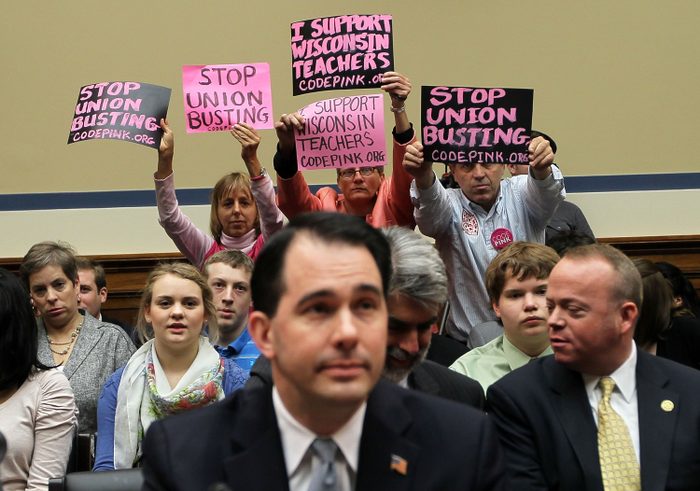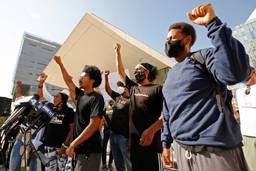Democrats Hold Trifecta Power in Over a Dozen States. Will They Actually Use It?
Republicans have used legislative majorities at the state level to undermine their opposition, but the Democratic Party has often failed to fight back. This is a chance to change that.
Mark Engler and Paul Engler

“It’s a goddamn trifecta,” declared Michigan State Sen. Dayna Polehanki last November, after Democrats gained control of the governor’s mansion along with both houses of the state’s legislature in the 2022 elections.
On January 11, Michigan’s 148 state legislators took their seats to begin a new session, with Democrats enjoying a historic reversal of fortune. As recently as 2018, Republicans led all branches of state government. This situation has now flipped with Democrats controlling the state’s House of Representatives for the first time in a decade, and the State Senate for the first time in nearly 40 years.
Last year’s elections presented other bright spots for progressives as well: Democrats also hold new trifectas in Maryland, Massachusetts and Minnesota. In total, the party now fully controls governments in 17 states, with combined populations that account for 140 million Americans — compared to the 137 million people living in the 22 states controlled by Republicans. This represents enormous progress from just over four years ago, when, prior to the 2018 midterm elections, 26 of the 34 states with trifectas were under Republican control.
Democratic leaders in Michigan and beyond are now in a position to pursue a strong governing agenda. The question is: Will they take advantage of the opportunity? More specifically, will they use their power to enact changes that increase democratic participation and build progressive power for the long term?
Over the past 20 years, Republicans have invested heavily at the state level, and when they have gained majorities, they have used their power to push through reforms that weaken left-leaning constituencies and undermine the Democratic base. In contrast, when Democrats have been in the majority, they often have failed to reverse these changes or enact meaningful structural reforms — the kind of changes that both improve people’s lives and build power for the grassroots groups that can help them govern on an ongoing basis. In particular, they have failed to protect organized labor — arguably the most important organized bloc in the Democratic coalition.
With the new trifectas in place, Democrats have an opportunity to eschew a neoliberal vision of winning by moving to the center and instead pursue a strategy that creates the kind of grassroots power which can pay dividends for years to come. Such an approach would include repealing “right to work” laws and pursuing reforms that expand labor rights, support social movement organizing and bolster democratic participation.
“We got ALL the gavels,” Michigan state Sen. Polehanki stated when Michiganders voted Democrats into power. “Get ready for some cha-cha-cha-changes here in Michigan.” Or as Ken Whittaker, executive director of the progressive group Michigan United, told Politico, “The people are on offense.”
The fall of Wisconsin labor
In order to mount an offensive, Democrats will need to break with their party’s history of disregarding the very forces that allow them to gain office in the first place. They will also need to get serious about countering GOP moves to tilt the playing field in favor of the Right.
For decades, Republicans have out-organized, outmaneuvered and outspent the Democratic Party at the state level. And when conservatives have won control of state governments, they have been adept at using their majorities to reinforce their hold on power. Well-publicized moves to aggressively gerrymander legislative districts, enact restrictive voter ID laws and pass other measures to limit the franchise have helped lock in Republican advantages at the polls. But beyond manipulating the electoral system to their advantage, conservatives have consistently used trifecta power at the state level to undermine the organized groups that form the backbone of progressive politics.
Just look at the Right’s attacks on unions, and at the Republican elected official who provided the modern template for dismantling organized labor: former Wisconsin Gov. Scott Walker.
In November 2010, Walker was elected as the state’s first GOP governor in more than a decade, having been heavily backed by the Koch brothers and the Republican Governors Association. On the campaign trail, Walker railed against unionized public employees as selfish and greedy at a time when the state government faced a severe budget deficit. The strategy worked. Walker rode the Tea Party wave into office, and both chambers of the state legislature flipped from blue to red. For the first time since 1998, Republicans controlled all three branches of the Wisconsin state government.
In office, Walker used his power to mold Wisconsin into a permanent right-wing state. Shortly after being sworn in, he was filmed attending a local economic development meeting where he was greeted by Diane Hendricks, a Wisconsin billionaire. Hendricks asked Walker if there “was any chance we’ll ever get to be a completely red state, and work on these unions.” In particular, she wondered if Wisconsin might be able to adopt so-called “right-to-work” laws, commonly in place in the South, that weaken bargaining power and deplete union resources by allowing employees in a unionized workplace to opt out of paying dues.
Walker responded with considerable candor, making clear that undermining organized labor would be a central part of his strategy to reorient Wisconsin politics. “The first step,” he explained, “is we are going to deal with collective bargaining rights for all public employee unions because you divide and conquer.”
In early 2011, just weeks after taking power, Walker and the Republican majority in the legislature successfully pushed forward sweeping anti-union legislation, framed as an emergency budget bill: Act 10. As journalist Dan Kaufman explains in his 2018 book, The Fall of Wisconsin: The Conservative Conquest of a Progressive Bastion and the Future of American Politics, the bill introduced a devastating series of rules changes. Among other measures, Act 10 required public sector unions to hold recertification elections annually, prevented public workers from negotiating raises larger than the rate of inflation, and stopped unions from automatically collecting dues from members’ paychecks, even if they had a worker’s written consent.
In a July 2021 op-ed for the New York Times, Kaufman reflected on the tenth anniversary of Act 10’s enactment and surveyed its devastating impact. “Wisconsin’s public sector unions have lost about 70 percent of their members on average over the past decade,” he explained. When coupled with the passage of the state’s right-to-work law in 2015, which Walker also pushed through, the two pieces of legislation helped lead to a 40 percent decline in overall union membership. “Now barely 8 percent of Wisconsin’s workforce are members of a union,” Kaufman wrote, “roughly the same percentage as in Alabama, a state with a long and violent anti-labor history.”
Veteran conservative strategists recognized their victory over labor in Wisconsin as more than a policy win — they saw it as a key step toward securing permanent rule. The most Machiavellian expression of this thinking came from prominent anti-tax leader Grover Norquist, who wrote in a 2017 op-ed: “To understate it: If Act 10 is enacted in a dozen more states, the modern Democratic Party will cease to be a competitive power in American politics. It’s that big a deal.”
A template for ruthless Republican rule
The strategies Wisconsin Republicans used to undermine progressive institutions in their state are part of a larger right-wing agenda that, over time, has morphed from wish list to playbook. Efforts are coordinated by institutions such as the American Legislative Exchange Council (ALEC) and the dozens of conservative think tanks that make up the State Policy Network, which are relentless in promoting policies that embolden conservative interests while depleting the Democratic base.

ALEC has existed since the 1970s but rose to prominence in the Obama era for drafting model bills that were increasingly being introduced — sometimes verbatim — in Republican-controlled state legislatures across the country. The organization’s imprint has been clear: In 2015, the progressive Center for Media and Democracy revealed that Wisconsin’s “right-to-work” bill was almost a word-for-word copy of ALEC’s model “Right to Work Act,” containing only a few stylistic edits. Copycat measures were introduced in many other state capitals as well. In 2001, Oklahoma passed an anti-labor constitutional amendment using language that was almost identical to ALEC’s model legislation at the time, and, in 2012, a conservative trifecta in Michigan adopted a “right-to-work” law that included language which closely tracked ALEC’s model legislation.
Outside of these cases, Indiana, West Virginia and Kentucky also adopted “right-to-work” laws between 2012 and 2017. Subsequently, the conservative majority on the U.S. Supreme Court struck a major blow against labor in their 2018 Janus v. AFSCME decision, which essentially nationalized “right-to-work” provisions for public sector unions by ruling that these organizations could not collect “fair share” fees from government employees to provide for the costs of representation.
Union-busting efforts by Republicans have gone well beyond “right-to-work” to replicate many of the onerous union-busting provisions of Wisconsin’s Act 10. In his 2014 Washington Post analysis of “How ALEC helped undermine public unions,” Harvard graduate student researcher Alexander Hertel-Fernandez found that, to that date, eight state governments had enacted ALEC-authored laws related to public unions, and that these laws effectively resulted in lower public union density, typically within just a few years of their enactment.
The impact of such decline on Democrats’ ability to hold power is hardly lost on conservatives. A month after the 2016 elections, Kyle Peterson of the Wall Street Journal wrote a story previewing “The Spoils of the Republican State Conquest,” tying Republicans’ national electoral success to the party’s effectiveness in passing structural reforms in the states. “In Wisconsin. union membership is down 133,000 since 2010, the year before Gov. Scott Walker’s Act 10 overhaul passed,” Peterson wrote. “Donald Trump’s margin of victory there? Less than 30,000. In Michigan, public-union membership is down 34,000 since 2012, the year before Gov. Rick Snyder’s right-to-work law kicked in. Mr. Trump’s margin? Only 11,000.”
Peterson’s article prominently featured Tracie Sharp, president of the State Policy Network, who directly connected the erosion of unions to the Republicans’ rising fortune. “When you chip away at one of the power sources that also does a lot of get-out-the-vote,” Sharp said. “I think that helps — for sure.”
Sharp had previously written a 2016 fundraising letter for the State Policy Network highlighting how right-wing efforts to encourage teachers to opt-out of their unions in the wake of right to work helped wipe 13,000 members off labor’s rolls and “resulted in $8 million annually being drained from the teacher union coffers.” Sharp characterized the impact of anti-union measures in explicitly political terms, identifying them as “a major blow to the Left’s ability to control government at the state and national levels.”
In his 2017 op-ed, Grover Norquist was even more clear in connecting policy changes enacted by Republicans at the state level to conservatives’ ability to hold power. Referencing Wisconsin’s anti-union Act 10, he wrote:
Currently, there are 25 states with Republican control of the governorship and both houses of the legislature. If half of them pass Act 10 or its equivalent, the collapse of union dues cannot be replaced by any collection of progressive billionaires…. In short, Act 10 is campaign finance reform….
Like parallel trench lines approaching a besieged fortress, Act 10 cannot be stopped, and once enacted the state becomes red. No states with Act 10 can continue to be part of the once-vaunted “Blue Wall,” and it is difficult to see how a state that enacts Act 10 could repeal it. Of the 28 right-to-work states, only one repealed it, and later repassed it.
Wisconsin, which had not voted for a Republican candidate for president since 1984, voted for Trump five years after Act 10 passed and re-elected Sen. Ron Johnson, whom Democrats and Republicans believed to be the second most likely Republican to lose in 2016.
Trump’s tweets attract attention. Act 10 moves forward. Quietly. Inexorably. Changing the political landscape like a glacier.
Conservatives have found other ways to attack organized labor as well. For example, school vouchers promoted by Republicans who paint themselves as champions of “school choice” further undermine teachers’ unions by defunding traditional public institutions and diverting state money to private schools and non-union charters. The supportive role of pro-charter Democrats in these campaigns illustrates the gap in thinking about power-building that exists between the parties.
Nor is the labor movement the only progressive constituency to be affected by structural reforms pushed by the Right. Trial lawyers have been another major target — an unsurprising fact given their importance in Democratic Party fundraising. As Timothy Carney, columnist for the conservative Washington Examiner, explained in 2014, “Lawyers and law firms have given more money to House and Senate candidates and party committees than any other industry, with an overwhelming majority going to Democrats.”
The legislative strategy of “tort reform” represents a tidy solution to this problem. By the time President George W. Bush made limiting corporate exposure to consumer lawsuits one of the signature issues of his 2004 campaign, right-wing strategy guru Karl Rove had been laboring to elevate the topic for the better part of two decades. Working at the state level in Texas, Rove saw that depicting plaintiff-side attorneys as “economy-draining” and “ambulance-chasing” would not only protect big-business donors in industries including tobacco and asbestos from facing litigation and large settlements. He understood that it could also be a path toward building GOP power — something Texas Republicans did very effectively in the 1990s. As a PBS Frontline investigation put it, Rove “grasped its significance before others did, capitalized on it in the races that he ran in the 1980s and made tort reform a propelling factor in the Republicans’ ascendancy in Texas.”
“I think it’s Rove genius at work,” said Sam Gwynne, executive editor of Texas Monthly. With a clear knowledge that donations from trial lawyers were central to “the financing of the entire Democratic Party. Karl saw… that this was the wave to ride. And he rode it,” Gwynne explained. By the 1990s, the issue became so polarized that it grew into “a battle for the soul of Texas politics” — and, Gwynne argued, Republican success in passing state reforms directly curtailed “the lifeline money of Democrats, which is now drying up.”
Republicans’ impressive state-level gains in Texas paved the way for the issue to be nationalized on starkly polarized terms. ALEC’s slate of model legislation now features a raft of sample tort reform bills—more than 70 of which were introduced by red-state Republicans in 2013 alone, according to the Center for Media and Democracy. Prominent among the conservatives who have advanced such laws have been Scott Walker and Wisconsin lawmakers who gained trifecta power in 2011 and swiftly made tort reform another of its signature victories.
Democrats fail to fight back
While Republicans have had a proactive and visionary game plan to undermine the Democratic base and consolidate GOP power, Democrats have mostly been playing defense.
There are several possible explanations for the party’s reluctance to fight for workers at the national or state levels in ways that could improve conditions for most Americans and consolidate Democratic power in the long term. One is that its candidates, too, have frequently opted to court well-heeled donors who are at odds with labor’s agenda, creating divided loyalties among lawmakers. Democratic officials are generally not as ideologically motivated as GOP officials, nor are they as unified around an overall vision for society. Their party has been divided between progressives and neoliberals in the mold of Bill Clinton and Rahm Emanuel — factions that, in a European multiparty system, would likely be housed in distinct and possibly hostile organizations.
Party unity has been further undermined by opportunistic centrists, such as Sens. Joe Manchin (W.V.) and Kyrsten Sinema (Ariz.) in the U.S. Congress, or the Independent Democratic Conference in the New York State Senate, who have found it personally advantageous to defect from the party’s majorities at critical moments.
These neoliberals and centrists believe that Democrats must win by playing to the middle and co-opting Republican issues — whether on crime, schools, support for corporate enterprise or fiscal austerity. Such a strategy sometimes produces short-term wins, but it undermines the base of the Left. And since the party is not meaningfully using its power to build up its core constituencies, it creates a hollow organization that is all too vulnerable to Republican attack.
Finally, compounding these problems, the party’s numerous insider wonks envision politics as a matter of crafting clever policy ideas, rather than a zero-sum contest for power. And a liberal desire for civility and bipartisanship has positioned Democrats to fare poorly in the type of political combat that Norquist describes.
For whatever combination of reasons, Democratic leaders have commonly seen social movements as special interests to appease with minimal concessions, rather than as factors critical to their long-term success. They have focused little on shoring up, let alone expanding, the power of organized labor, despite pressure from the grassroots base to do so.
At the level of national politics, the Democrats have repeatedly failed to revamp labor law through multiple administrations — with President Bill Clinton instead spurning unions with the passage of the North American Free Trade Agreement. As longtime political journalist Robert Kuttner writes in his 2018 book, Can Democracy Survive Global Capitalism: “Here again, the asymmetry between a ferociously strategic, corporate Republican Party and a compromised Democratic Party is telling.”
For a half century, the labor movement has been telling Democratic administrations that U.S. labor law is hopelessly outdated, and that employers who squash unionization drives by intimidating employees and firing pro-union leaders suffer few consequences. “But the presidential Democratic Party, whipsawed between a liberal/labor wing and a Wall Street/New Democrat wing, has not been willing to make it a priority to help working people exercise their rights under the Wagner Act,” Kuttner writes, even when Democrats held majorities in Congress, “as they did for four years under President Carter, two under Clinton, and two under Obama.”
Among state-level leaders, the problem is significantly more pronounced. Democratic fecklessness after gaining trifecta power has served as a mirror-image contrast to Republican tenacity. And in key instances, the party has squandered opportunities to institutionalize change. What happened in Iowa in 2008 is a clear example. Democrats had gained a trifecta the year before, with organized labor supporting Gov. Chet Culver in a hard-fought race, largely as a result of his promise to overturn the state’s right to work law. But when union members finally ushered a bill through the statehouse that would have restored some power to workers’ organizations, Culver vetoed it.
Ken Sager, then the president of the Iowa Federation of Labor, AFL-CIO, expressed his disgust and dismay to the Iowa Independent. “We were very surprised,” he said, “and we’ve heard from a number of legislative leaders who were just as stunned as we were.” The labor federation’s newsletter, meanwhile, described Culver’s action as “out-and-out betrayal.” As the document reported, “The 2008 Legislative Session will go down in Iowa labor history as the session when a Democratic governor turned his back on the unions that enthusiastically supported him and helped get him elected.”
If Culver thought that playing to the center and rebuffing movement demands would brighten his future political prospects, he was mistaken. Electorally, the move proved to be a self-inflicted wound: Not only did it help seal his fate as a one-term governor, it marked the beginning of the end of the party’s competitiveness in Iowa politics. Culver lost his reelection bid to Republican Terry Branstad in 2010. The GOP gained control of the Iowa House of Representatives at the same time, and took control of the Senate a few years later. In 2017, within months of securing a unified government, Iowa Republicans passed anti-union measures even more extreme than Wisconsin’s. They have held a trifecta in the state ever since.
Similar tensions played out between then-Gov. Bill Ritter and the labor movement in Colorado. Like Culver, Ritter was a Democrat who was elected in 2006 and took office in 2007; and as with Culver, new Democratic majorities in both houses of state government gave him a historic opportunity to pursue structural reforms. Yet, although Ritter had relied on labor to back his campaign, he promptly vetoed a 2007 bill that would have made it easier to form unions by eliminating one of the two elections Colorado requires in workplaces interested in unionizing: one to form a union and another to form an all-union shop.
Then, in May 2009, Ritter vetoed a subsequent bill that would have made it easier for workers locked out of their job sites to receive state unemployment payments. Weeks later, he vetoed a third bill passed by Democrats that would have guaranteed collective bargaining rights for firefighters.
“When he campaigned, he made it clear he was behind the labor movement,” Steve Vairma, then secretary treasurer of Teamsters Local 455, said at the time. “We’re tired of seeing bill after bill falling to his pen. He’s not the man we thought we were electing.” Later, union members picketed several of Ritter’s fundraising events in Washington in 2009, and others appeared at protests in Colorado bearing signs with the rhetorical question, “Why does Ritter hate working families?”
Like Culver, Ritter also became a one-term governor. Of his anti-union vetoes, Dave Kenney, manager of Ritter’s aborted reelection campaign, said simply, “Sometimes being governor means saying no to your friends.”
Can this time be different?
Although the state-level election results from 2022 provide some glimmers of hope that this time could be different, worrying signs are already emerging.
On the positive side, over the last several years Democratic strategists, seeking to learn from strategic failures of the past, have begun taking state-level races more seriously and investing in them accordingly. They are also getting better at exercising power in state legislatures already under Democratic control. Progressive groups such as the State Innovation Exchange, Forward Majority, the States Project and Sister District have begun to compete with conservative organizations such as ALEC and the State Policy Network, both in winning governing majorities and in advocating legislation.
This year, among other gains, Democrats won gubernatorial elections in three key “blue wall” states: Michigan, Pennsylvania and Wisconsin. They also flipped Michigan’s legislature from red to blue, won the majority in the state senate needed to create a trifecta in Minnesota, gained the governorships that give them unified governments in Massachusetts and Maryland, and retained control of both legislative bodies in Colorado, Maine, Nevada and Oregon.
“We’re clawing our way back to power after 50 years of investment for Republicans and so much neglect for so long by the Democratic Party,” Vicky Hausman, president of Forward Majority, recently told Axios.
The question is, how will lawmakers use this newfound power?
In the upcoming legislative session, Democratic leaders in blue states are vowing to better fund public schools, expand early childhood education, tighten gun restrictions, protect affordable housing and bolster tax credits for low- and middle-income workers. These are all sensible reforms that would make meaningful improvements in people’s lives, but none are oriented toward shifting power in the long term.

Even in trifecta states, Democrats’ strategy still amounts to playing defense. Going on offense would entail learning from the Right’s unashamed boldness. It would mean using Democratic majorities to build social movements and redistribute power and resources in a more durable way — putting a premium on the types of changes sometimes discussed as “policy feedback loops” or theorized by socialists as “non-reformist reforms.”
Of the new trifecta states, Michigan and Minnesota are the most pivotal, and the two may end up previewing different possible futures for the Democratic Party.
In Michigan, there are indications that Democrats may repeat past mistakes. After last year’s election, progressives were initially bullish on what they might accomplish. Incoming Democratic state Sen. Darrin Camilleri stated, “We are incredibly serious about repealing right-to-work. It was something that was jammed through this legislature 10 years ago by Republicans who did not care about unions or working people.”
Unlike states such as Nevada that have long been right to work, Michigan’s anti-union law is relatively new, and it was a massive blow in a state with a proud history of labor mobilization and a high concentration of blue-collar workers. For that reason, overturning the law would have symbolic significance. Upon the start of the new legislative session, Democrats announced their initial bills, which critically included putting the repeal of right-to-work on the docket.
However, these steps notwithstanding, Michigan Democrats may yet squander the chance they have earned. Slim margins in each chamber raise dangers that the caucus will not hold discipline among its members. Already, there are signs of hedging. As the Detroit News reported on January 11, “Democrats have been debating how quickly to advance right-to-work repeal in the new term” and Senate Majority Leader Winnie Brinks “was noncommittal Wednesday on whether she wanted to repeal the law.”
Gov. Gretchen Whitmer has also been less than enthusiastic, stating on January 10 that the right-to-work repeal would not be her top priority: “I’m not going to lead with that,” she said. Local activists had expressed dismay that other Democratic lawmakers have similarly shifted toward lowering expectations and calling for bipartisan cooperation.
The revived political standing of Michigan’s Democrats was made possible in the first place by a grassroots-led redistricting drive. A product of the anti-Trump resistance, the campaign put forward a wildly successful 2018 ballot initiative that took the drawing of districts out of the hands of conservatives and ultimately paved the way for progressive challengers to compete in many parts of the state.
The initiative was an excellent example of the types of reforms that can have lasting consequence in reshaping the political landscape. But if Democrats fail to support their base, their time in power may be short. As Branden Snyder, executive director of grassroots Detroit Action, told Politico in November, “To slow-play that or not do it at all gives the clear signal to people who voted for this monumental flip that our legislators aren’t taking them seriously.”
Mimicking the Minnesota model
Amid worries that such a flop may materialize, Minnesota offers a considerably more hopeful alternative. A decade ago, the Democratic – Farmer – Labor Party, or DFL, as the party is idiosyncratically known there, secured a very rare trifecta when the 2012 elections flipped both houses of the state legislature. Although it only lasted for two years, lawmakers defied the trend of Democratic fumbling seen in Iowa and Colorado and instead took full advantage of their majority.
In what Mother Jones dubbed “Wellstone’s Revenge,” after the late progressive Senator Paul Wellstone, the party passed a torrent of legislation including measures that created a public health insurance exchange, opened universal free all-day kindergarten to students throughout the state and hiked taxes of the wealthy. They also raised the minimum wage and indexed it to inflation, ensuring that the floor would steadily rise without the need for repeated legislative battles.
In terms of structural reforms, the legislature notably passed legislation extending organizing rights to previously excluded child care and home healthcare workers. When some 20,000 healthcare workers subsequently exercised these rights and joined unions, it contributed to the most significant expansion of the state’s labor movement in decades. Between 2014 and 2022, union membership in Minnesota — which, like unionization levels nationally, had declined substantially in the twenty years prior — began a marked rebound. While the state was home to 360,000 union members in 2014, that number increased to 416,000 over eight years. Contrary to conservative predictions that progressive measures would sink Minnesota’s economy, wage growth surged in the state.
Republicans recaptured the state House of Representatives in the 2014 elections, initiating nearly a decade of divided government. But DFL wins in this past year’s midterms have created another moment of opportunity. With a new trifecta in place, Minnesota Democrats are again poised to provide a model for how to make transformative change. The DFL has previewed plans to tackle a long list of issues, from guaranteeing abortion rights to legalizing marijuana, restricting access to guns, boosting school funding, creating child care supports, expanding clean energy and mandating paid family and sick leave.
Lawmakers are also pursuing changes that can fortify movements and alter the ongoing balance of power in the state. On January 6, the anniversary of the right-wing insurrection at the U.S. Capitol, DFL leaders announced that they were introducing a robust bill to expand voting rights. Building on already-strong protections in the state, the measure would institute automatic voter registration for 18-year-olds, restore the franchise to formerly incarcerated people, increase transparency around campaign finance and solidify vote-by-mail options.
“We knocked on 500,000 doors during the campaign,” Senate Majority Leader Kari Dziedzic told an area NBC outlet in early January. “We listened to Minnesotans tell us that they were concerned that our democracy remains under attack, both at the state level and at the country level.”
On the labor front, advocates are pushing for provisions that would give public sector unions access to new employees during their orientation, so that they would have the opportunity to promptly sign up as members — similar to a law that passed in California in 2022. They are also pursuing changes to state employment law that would allow striking workers to collect unemployment insurance, which could provide serious support for labor militancy. Finally, legislative approval is expected to be granted for a landmark contract with home healthcare aides which will afford dramatic improvements in the livelihoods of low- to moderate-wage workers and further validate a decade of intensive organizing.
“We’re aligned on our values and our priorities and we’re ready to work hard and work quickly to meet the needs of Minnesotans,” House Speaker Melissa Hortman told the local CBS affiliate.
Local labor leaders counsel that such speed is warranted, and that history shows advance preparation on the part of progressive groups is essential to making progress. Policy proposals that were fully baked and ready to go at the start of the 2013 session fared well, and the major gains of the two years of unified government mostly moved forward in the early months of that trifecta. However, by the next year, when elections loomed for legislators who were back on the ballot in 2014, the appetite for ambitious reform faded.
Some more reliably blue states have demonstrated that other public policies can support organizing. In 2010, Oregon enacted a measure banning “captive audience” meetings in which employers push anti-union positions on employees. And this past November, voters in Illinois approved a constitutional amendment enshrining collective bargaining rights in their state’s constitution, effectively ensuring that the state cannot adopt a right-to-work law. As Liz Shuler, President of the AFL-CIO, told Politico, “Illinois could be a roadmap for other states,” including “how that campaign was waged and the narrative and the secret sauce that we can spread around to other states.”
We will see over the coming months whether new Democratic trifectas in the states will replicate the past failures of Bill Ritter and Chet Culver, or whether they can take inspiration from the initiative of Minnesota progressives. But if the party is to hold off an onslaught by Republicans who are unafraid to push a deeply conservative agenda, leaders must recognize that no task is more important to Democrats’ future than implementing policy that fosters the building of power from below.
Research assistance provided by Raina Lipsitz and Sean Welch.
Mark Engler is a writer based in Philadelphia and an editorial board member at Dissent. Paul Engler is founding director of the Center for the Working Poor, in Los Angeles, and a co-founder of the Momentum Training. They are co-authors of This Is an Uprising: How Nonviolent Revolt Is Shaping the Twenty-First Century (Nation Books), and they can be reached via the website www.democracyuprising.com.







